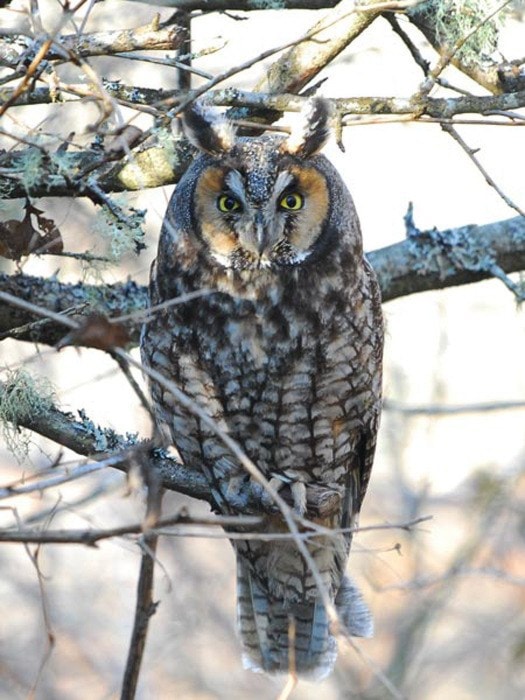This fall and winter has seen a variety of owls at MARS, many of which like the barred, saw whet and pygmy owls are regular patients.
One of the most secretive and elusive is the long eared owl which is not often seen at our centre. Long eared owls seem to have combined the best features from all the other species, having the purest “hoot”, the most cryptic plumage, the most hypnotic eyes and the longest ear tufts. Barred owls are known for their mastery of hunting mice, but long eared owls have even surpassed them at being “master mousers.”
Long eared owls are medium sized owls that inhabit open woodlands, forest edges, and riparian strips along rivers for hunting while they require thickly wooded areas for nesting. These owls are widely distributed across North America, Eurasia and northern Africa but they are not often seen on Vancouver Island.
Found in the interior of B.C., there are also small populations residing in the Boundary Bay area. We have certainly been witness to some unusual and spectacular bird species this winter and the long eared owl is another fascinating bird.
On first impression the long eared owl can easily be mistaken for the short eared owl as they closely resemble each other, but as I researched further I found them to be significantly different. Long eared owls have very prominent ear tufts which sit more in the centre of the head than a great horned owl. They have large golden yellow eyes that are surrounded by bright orangey brown facial disc feathers; the black beak is separated from the eyes by a cross of white feathers and they also have a white chin patch.
Their overall plumage is a cryptic combination of brown and buff mottling with heavy barring on the chest; this provides them with the perfect camouflage when roosting during the daytime. These owls weigh between 250 and 280 grams with a long wingspan measuring between 96-100 centimeters.
The female is the larger of the two sexes. Buoyant and manoeuvrable, they are the ultimate silent fliers whether gliding or flapping their wings – serrated feather edges provide them with this ability. They are able to navigate equally as efficiently through open woodlands and through dense brush.
When searching for food they resemble a moth, hovering and fluttering before pouncing on their prey. The same method is used by the short eared owl except they hunt in open grasslands during the day. Long eared owls are strictly nocturnal and rival the barn owls in their ability to catch prey in total darkness. Hunting just after dark and pre-dawn they fly low to the ground with their heads atilt listening for the patter of tiny rodent feet. Their diet includes mice, voles, moles, squirrels, bats and they will even prey on smaller owls as well as juncos, and small birds that they catch whilst in flight.
Vocalization for these birds is very diverse and the sound penetrates the forests for at least a kilometre. I listened to a recording of their calls which was incredible. This included a series of long “hoots” followed by a long throaty “moan,” finished off by a small series of barks and yaps. Another similarity with the short eared owls is the sound they produce during their mating ritual which is made by clapping their wing under their bodies.
The female also has a bizarre ritual she uses to ward off a predator when she is protecting the nest. Rather than dive bomb the intruder she flies to the ground where she proceeds to have a “hissy fit,” rolling and shrieking, whining and hissing until the intruder leaves.
Unlike the short eared owls the long eared does not nest on the ground or in cavities instead they reuse old stick nests built by ravens, hawks and herons that usually hidden close to the tree trunk behind a screen of foliage. Eggs are produced over a five or six day period so that hatching occurs on different days. The owlets are fed in the nest for five weeks and must be ready to fend for themselves within two months.
Like all wildlife, predators are always close by, and the long eared owls are preyed upon by great horned and barred owls, and their eggs are enjoyed by raccoons. Due to their nocturnal habits they are very prone to vehicular impacts and as a result sustain some very serious injuries.
MARS received a badly injured owl from Sayward that was almost certainly hit by a vehicle and was in need of immediate surgery. Our long eared owl is still recovering from a compound fracture of the ulna bone in the wing, which required surgery to pin the fracture and stabilize the wing.
It joins the list of high maintenance patients who are recovering well, including the snowy owl, and the brown pelican, and their chances of release look promising. Please visit our web site and Facebook to get up to date reports on our patient’s progress.
To report injured wildlife please call 1-800-304-9968. A huge thank you to all those who voted for us: we were one of the five winners of BC Hydro’s community funding. And another huge thank you to Myra Falls mine in Strathcona for their generous donation.
2012 proved to be a very busy but rewarding year; we look forward to continue this important task of caring for wildlife through education and rehabilitation. For more information visit www.wingtips.org.
Sandy Fairfield is the educational co-ordinator for the Mountainaire Avian Rescue Society (MARS). The MARS column appears every second Friday.
